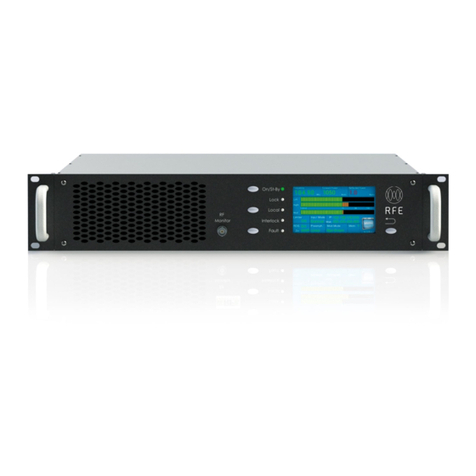GENERAL
Power Output:6000W, adjustable from front panel.
RF Output Impedance: 50 ohm.
RF Output Connector: “7/8”.
Monitor RF: BNC connector.
VSWR: 1,5:1
Frequency Range: 87.5 ÷ 108.00 MHz, only for analog on request
66 ÷ 74 MHz ( OIRT), 76 ÷ 90 MHz (JPN) Programmable in 10 kHz steps.
Frequency Stability: ±1 ppm from -5 to 45°C.
External Reference: 10 MHz SMA connector back panel.
Type of Modulation: DS series analog synthesis, Option full digital
synthesis.
Off Lock Attenuation: ≥ -80 dBc.
Modulation Capability: ±150 KHz.
Limiter built in
Power Good Detector: adjustable from20÷90% of the power.
Audio Presence Detector: adjustable time from front panel.
External AGC: Automatic, with fine ADJ from front panel.
Modulation Mode: Mono, Stereo, Multiplex, SCA, RDS, Aux.
Preemphasis: Flat/50/75µs selectable from front panel.
Asynchronous AM S/N Ratio: -70 dB.
Synchronous AM S/N Ratio: -65 dB .
RF Harmonics: Exceeds EBU/CCIR/FCC requirements.
RF Spurious: Exceeds EBU/CCIR/FCC requirements.
MONAURAL OPERATION
Audio Input Impedance: 600 ohm - ≥10 Kohm balanced.
Audio Input Level: Digital -12 to +12 dBm, Analog -6 to +12 dBm
Input Connector: XLR female.
Audio Frequency Response: ±0.1 dB, 30 Hz to 15 KHz.
Total HarmonicDistortion + Noise: 0.01% @ 400 Hz.
Intermodulation Distortion: 0.01%, 1 KHz/1.3 KHz, 1:1 ratio.
Transient Intermodulation Distortion: 0.01% 2.96KHz square wave and
14 KHz sine wave.
Distortion: 0.01% 2.96KHz square wave and 14 KHz sine wave.
FM S/N Ratio: -80 dB rms detector,-75 dB below ±75 KHz deviation.
STEREO OPERATION
Audio Input Impedance: 600 ohm - ≥10 Kohm balanced.
Audio Input Level: Digital -12 to +12 dBm, Analog -6 to +12 dBm Input
Connector: XLR female.
Audio Frequency Response: ±0.1 dB, 30 Hz to 15 KHz.
Total Harmonic Distortion + Noise: 0.01% @ 400 Hz.
Intermodulation Distortion: 0.01%, 1 KHz/1.3 KHz, 1:1 ratio.
Transient Intermodulation Distortion: 0,01% 2.96KHz square wave and
14 KHz sine wave.
FM S/N Ratio: -80 dB rms detector, -75 dB below ±75 KHz deviation.
Stereo Separation: Digital 20 Hz ÷ 15 KHz ≥ -60dB, Analog -45 dB@30Hz
≥ -60dB@ Freq ≥ 100 Hz
Crosstalk attenuation: Digital Main to Sub -70 dB 30 Hz to 15 KHz,
Analog ≥ 45 dB@15kHz.
38 KHz Suppression: ≥ -85 dB.
Pilot Frequency: 19 KHz ± 1 Hz
Output Pilot: Digital 1 Vpp. BNC female, analog 2Vpp adjustable from
front panel
SIGNAL PROCESSING SECTION (only for Digital)
FM Carrier Generation: NCO-based synthesis
FM Modulation: Fully digital
Stereo Coder: Fully digital, integrated
Input Audio Limiter: Proprietary integrated Soft Limiter
Digital Signal Processing: Real-time internal24-bit digital processing
RDS Generator: Fully integrated
Monitoring Output Signals: Fully digitally generated
MULTIPLEX OPERATION
Composite Input Impedance: 2 Kohm unbalanced.
Composite Input Level: Digital -12 to +12 dBm, Analog -6 to +18 dBm
Input Connector: BNC female.
Composite Amplitude Response: ±0.1 dB, 30 Hz to 100 KHz.
Total Harmonic Distortion + Noise: 0.01% @ 400 Hz.
Intermodulation Distortion: 0.01%, 1 KHz/1.3 KHz, 1:1 ratio.
Transient Intermodulation Distortion: 0.01% 2.96KHz square wave and
14 KHz sine wave.
FM S/N Ratio: -80 dB rms detector, -75 dB below ±75 KHz deviation
AES/EBU OPERATION (optional for Analog)
Input Connector: XLR female, optical TOS-LINK.
Data Format: S/PDF,AES/EBU, IEC958, EIAJCP340/1201.
D/A Converter: 24 bit.
Sampling Frequency: from 32 to 96 KHz.
AUDIO IP (optional)
Lan: Audio IP and Web interface to control and configure
Transport protocol: RTP over UDP;
Protocols: RFE Codec: Alaw,OGG VORBIS, MP3, AAC
SHOUTCAST/ICECAST Codec : TX MP3, RX AAC, AAC+, MP3,
OGG(icecast 2.x)
SCA, RDS, AUX OPERATION
Input Impedance: ≥ 2 Kohm.
Input Level: -6 to +12 dBm.
Frequency Response: ±0.1 dB, 50 KHz to 100 KHz.
Input Connector: BNC female.
AUXILIARY CONNECTIONS
RS485: DB9 connector back panel.
CAN BUS (optional): DB9 connector back pane
Telemetry Interface: connector DB25 back panel.
LAN: RJ45 connector back panel
MPX OUT: connector BNC back panel.
OPTIONS
RDS/RBDS Programmable Coder via PC.
OIRT or JPN version.
SNMP
Audio Over IP
AES/EBU (only for Analog)
ELECTRICAL
AC Input Power: 90÷260 VAC 50/60 HZ single phase.
AC Apparent Power Consumption: 8500VA
Cos Ф> 0.98.
Cooling: Forced air.
Acoustic noise:< -56 dBa @ 1 meter.
ENVIRONMENTAL
Operating temperature: -5°C to +50°C.
Max Operating Altitude: 2000 mt.
Relative Humidity Range: 0 to 90%.
PHYSICAL DIMENSION
Mounting: Standard 19” chassis 4 U rack.
Size: W x 483 mm. D x 600 mm. H x 176 mm.
Weight: ~ 28Kg.
Software update
Core micro : Via Web




























